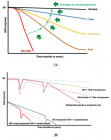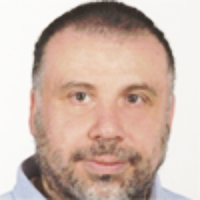Abstract
Mini Review
Environmental Factors Affecting the Concentration of DNA in Blood and Saliva Stains: A Review
Divya Khorwal*, GK Mathur, Umema Ahmed and SS Daga
Published: 07 May, 2024 | Volume 8 - Issue 1 | Pages: 009-015
DNA evidence has now become an essential part of forensic investigations since it offers vital information for person identification and crime resolution. However, the biological material is affected by some environmental factors which may impact the DNA in biological samples. This may affect the correctness and reliability of forensic DNA analysis. This review is related to the influence of various environmental conditions on the stability and degradation of DNA in biological stains including blood and saliva stains. The common factors that affect DNA are temperature, humidity, exposure to sunlight, and type of substrate. The information is crucial to improve forensic DNA analysis and forensic protocol optimization. The DNA stability and integrity in biological materials, such as blood and saliva stains, are indispensable for forensic DNA analysis. Environmental influences, however, significantly affect DNA concentration and may jeopardize forensic analysis. The present review explores various environmental factors for their effect on DNA stability in blood and saliva stains. While DNA degradation is slowed but not completely prevented by low temperatures, it is accelerated by high temperatures. Risks of contamination arise from the promotion of microbial growth and DNA breakdown by humidity. DNA photodamage brought on by sunlight exposure results in strand breakage and cross-linking. DNA stability is also influenced by the type of substrate used; porous surfaces, such as cloth, are better at keeping fluids than non-porous ones, such as glass. Maintaining the integrity of DNA evidence requires an understanding of these variables. The present studies will help to create sophisticated DNA preservation methods for use in forensic DNA examination. The study emphasizes the requirement of improvement in forensic DNA analysis skills, related to the preservation of DNA pieces of evidence and the possible effect of environmental factors.
Read Full Article HTML DOI: 10.29328/journal.jfsr.1001057 Cite this Article Read Full Article PDF
Keywords:
DNA; Forensic science; Blood stains; Saliva stains; Environmental factors; Degradation; Stability
References
- Sapan ÜT, Erdoğan IT, Atasoy S. Human identification from washed blood stains. Bulletin of the National Research Centre. 2021; 45:1-13.
- Shukla RK. Forensic Biotechnology: Application of Flow Cytometry in Legal Medicine. Ane Cr Care Med. 2016; 1(1): 000103
- Bukyya JL, Tejasvi MLA, Avinash A, P CH, Talwade P, Afroz MM, Pokala A, Neela PK, Shyamilee TK, Srisha V. DNA Profiling in Forensic Science: A Review. Glob Med Genet. 2021 May 31;8(4):135-143. doi: 10.1055/s-0041-1728689. PMID: 34877570; PMCID: PMC8635824.
- Bhoyar L, Mehar P, Chavali K. An overview of DNA degradation and its implications in forensic caseworks. Egyptian Journal of Forensic Sciences. 2024; 14(1):15.
- Allwood JS, Fierer N, Dunn RR. The Future of Environmental DNA in Forensic Science. Appl Environ Microbiol. 2020 Jan 7;86(2):e01504-19. doi: 10.1128/AEM.01504-19. PMID: 31704676; PMCID: PMC6952231.
- van Oorschot RAH, Szkuta B, Meakin GE, Kokshoorn B, Goray M. DNA transfer in forensic science: A review. Forensic Sci Int Genet. 2019 Jan;38:140-166. doi: 10.1016/j.fsigen.2018.10.014. Epub 2018 Oct 26. PMID: 30399535.
- Abdel Hady RH, Thabet HZ, Ebrahem NE, Yassa HA. Thermal Effects on DNA Degradation in Blood and Seminal Stains: Forensic View. Acad Forensic Pathol. 2021 Mar;11(1):7-23. doi: 10.1177/1925362121998547. Epub 2021 Mar 19. PMID: 34040682; PMCID: PMC8129487.
- Bond JW. Value of DNA evidence in detecting crime. J Forensic Sci. 2007 Jan;52(1):128-36. doi: 10.1111/j.1556-4029.2006.00323.x. PMID: 17209925.
- Nelson KL , Boehm AB , Davies-Colley RJ , Dodd MC , Kohn T , Linden KG , Liu Y , Maraccini PA , McNeill K , Mitch WA , Nguyen TH , Parker KM , Rodriguez RA , Sassoubre LM , Silverman AI , Wigginton KR , Zepp RG . Sunlight-mediated inactivation of health-relevant microorganisms in water: a review of mechanisms and modeling approaches. Environ Sci Process Impacts. 2018 Aug 16;20(8):1089-1122. doi: 10.1039/c8em00047f. PMID: 30047962; PMCID: PMC7064263.
- Ramey SLA. The Effects Humidity & Temperature Has on DNA Contamination(Doctoral dissertation, University of Montana). 2022.
- Smyth TJ, Betker J, Wang W, Anchordoquy TJ. Moisture content impacts the stability of DNA adsorbed onto gold microparticles. J Pharm Sci. 2011 Nov;100(11):4845-54. doi: 10.1002/jps.22697. Epub 2011 Jul 5. PMID: 21732371.
- Matange K, Tuck JM, Keung AJ. DNA stability: a central design consideration for DNA data storage systems. Nat Commun. 2021 Mar 1;12(1):1358. doi: 10.1038/s41467-021-21587-5. PMID: 33649304; PMCID: PMC7921107.
- Kim YW, Kim YK. The effects of storage of human saliva on DNA isolation and stability. Journal of Oral Medicine and Pain. 2006; 31(1):1-16.
- Zubakov D, Kokshoorn M, Kloosterman A, Kayser M. New markers for old stains: stable mRNA markers for blood and saliva identification from up to 16-year-old stains. Int J Legal Med. 2009 Jan;123(1):71-4. doi: 10.1007/s00414-008-0249-z. Epub 2008 Jul 2. PMID: 18594850.
- Naef T, Besnard AL, Lehnen L, Petit EJ, Schaik VJ, Puechmaille SJ. How to quantify factors degrading DNA in the environment and predict degradation for effective sampling design. Environmental DNA. 2023; 5(3):403-416.
- Abdulla JM, Gomaa R, Attalla SM, Nader LM. Investigation of DNA degradation in forensic blood samples after exposure to different environmental conditions. International Journal of Medical Toxicology & Legal Medicine. 2021; 24(1and2):66-74.
- Ambers A, Turnbough M, Benjamin R, King J, Budowle B. Assessment of the role of DNA repair in damaged forensic samples. Int J Legal Med. 2014 Nov;128(6):913-21. doi: 10.1007/s00414-014-1003-3. Epub 2014 May 3. PMID: 24792635.
- Carracedo A, Bär W, Lincoln P, Mayr W, Morling N, Olaisen B, Schneider P, Budowle B, Brinkmann B, Gill P, Holland M, Tully G, Wilson M. DNA commission of the international society for forensic genetics: guidelines for mitochondrial DNA typing. Forensic Sci Int. 2000 May 15;110(2):79-85. doi: 10.1016/s0379-0738(00)00161-4. PMID: 10808096.
- Graham E, May A. DNA: an overview. A Guide to Forensic DNA Profiling. Eds. Jamieson, Allan y Scott Bader. West Sussex, Reino Unido: John Wiley & Sons. 2014; 9-27.
- Butler JM. Short tandem repeat typing technologies used in human identity testing. Biotechniques. 2007 Oct;43(4):ii-v. doi: 10.2144/000112582. PMID: 18019344.
- Ginther C, Issel-Tarver L, King MC. Identifying individuals by sequencing mitochondrial DNA from teeth. Nat Genet. 1992 Oct;2(2):135-8. doi: 10.1038/ng1092-135. PMID: 1303263.
- Goodwin W, Linacre A, Hadi S. An introduction to forensic genetics. John Wiley & Sons. (Book). 2010; ISBN:9781119957614, 1119957613. https://books.google.co.in/books/about/An_Introduction_to_Forensic_Genetics.html?id=OVxe_dp04x8C&redir_esc=y
- Brettell TA, Butler JM, Almirall JR. Forensic science. Anal Chem. 2007 Jun 15;79(12):4365-84. doi: 10.1021/ac070871s. Epub 2007 May 17. PMID: 17506524.
- Lindenbergh A, de Pagter M, Ramdayal G, Visser M, Zubakov D, Kayser M, Sijen T. A multiplex (m)RNA-profiling system for the forensic identification of body fluids and contact traces. Forensic Sci Int Genet. 2012 Sep;6(5):565-77. doi: 10.1016/j.fsigen.2012.01.009. Epub 2012 Feb 22. PMID: 22361234.
- Gill P, Whitaker J, Flaxman C, Brown N, Buckleton J. An investigation of the rigor of interpretation rules for STRs derived from less than 100 pg of DNA. Forensic Sci Int. 2000 Jul 24;112(1):17-40. doi: 10.1016/s0379-0738(00)00158-4. PMID: 10882828.
- Badu-Boateng A, Twumasi P, Salifu SP, Afrifah KA. A comparative study of different laboratory storage conditions for enhanced DNA analysis of crime scene soil-blood mixed sample. Forensic Sci Int. 2018 Nov;292:97-109. doi: 10.1016/j.forsciint.2018.09.007. Epub 2018 Sep 15. PMID: 30292937.
- Althobaiti F, Alanazi ALT, Alharbi LAA, Alhussaini YAS, Alhazmi GA. Biotechnological applications in forensics: questioning the effect of sunlight conditions on DNA integrity extracted from blood and hair samples. Journal of Population Therapeutics and Clinical Pharmacology. 2024; 31(2):2000-2007.
- Bonsu DOM, Higgins D, Austin JJ. Forensic touch DNA recovery from metal surfaces - A review. Sci Justice. 2020 May;60(3):206-215. doi: 10.1016/j.scijus.2020.01.002. Epub 2020 Jan 30. PMID: 32381237.
- Virkler K, Lednev IK. Analysis of body fluids for forensic purposes: from laboratory testing to non-destructive rapid confirmatory identification at a crime scene. Forensic Sci Int. 2009 Jul 1;188(1-3):1-17. doi: 10.1016/j.forsciint.2009.02.013. Epub 2009 Mar 27. PMID: 19328638.
- Sijen T, Harbison S. On the Identification of Body Fluids and Tissues: A Crucial Link in the Investigation and Solution of Crime. Genes (Basel). 2021 Oct 28;12(11):1728. doi: 10.3390/genes12111728. PMID: 34828334; PMCID: PMC8617621.
- Bukyya JL, Tejasvi MLA, Avinash A, P CH, Talwade P, Afroz MM, Pokala A, Neela PK, Shyamilee TK, Srisha V. DNA Profiling in Forensic Science: A Review. Glob Med Genet. 2021 May 31;8(4):135-143. doi: 10.1055/s-0041-1728689. PMID: 34877570; PMCID: PMC8635824.
- Panneerchelvam S, Norazmi MN. Forensic DNA profiling and database. Malays J Med Sci. 2003 Jul;10(2):20-6. PMID: 23386793; PMCID: PMC3561883.
- Butler JM. The future of forensic DNA analysis. Philos Trans R Soc Lond B Biol Sci. 2015 Aug 5;370(1674):20140252. doi: 10.1098/rstb.2014.0252. PMID: 26101278; PMCID: PMC4580997.
- Kundu S, Mukherjee S, Bhattacharyya D. Effect of temperature on DNA double helix: An insight from molecular dynamics simulation. J Biosci. 2012 Jul;37(3):445-55. doi: 10.1007/s12038-012-9215-5. PMID: 22750982.
- Wartell RM, Benight AS. Thermal denaturation of DNA molecules: a comparison of theory with experiment. Physics Reports. 1985; 126(2):67-107.
- Tan X, Ge L, Zhang T, Lu Z. Preservation of DNA for data storage. Russian Chemical Reviews. 2021; 90(2):280.
- Burrows CJ. Surviving an Oxygen Atmosphere: DNA Damage and Repair. ACS Symp Ser Am Chem Soc. 2009 Dec 20;2009:147-156. doi: 10.1021/bk-2009-1025.ch008. PMID: 20458355; PMCID: PMC2865650.
- Ackerman S, Horton W. Effects of environmental factors on DNA: damage and mutations. In Green Chemistry. 2018; 109-128.
- Poetsch M, Markwerth P, Konrad H, Bajanowski T, Helmus J. About the influence of environmental factors on the persistence of DNA - a long-term study. Int J Legal Med. 2022 May;136(3):687-693. doi: 10.1007/s00414-022-02800-6. Epub 2022 Feb 23. PMID: 35195781; PMCID: PMC9005405.
- Prahlow JA, Cameron T, Arendt A, Cornelis K, Bontrager A, Suth MS, Black L, Tobey R, Pollock S, Stur S, Cotter K, Gabrielse J. DNA testing in homicide investigations. Med Sci Law. 2017 Oct;57(4):179-191. doi: 10.1177/0025802417721790. Epub 2017 Aug 4. PMID: 28776465.
- Thompson R, Zoppis S, McCord B. An overview of DNA typing methods for human identification: past, present, and future. Methods Mol Biol. 2012;830:3-16. doi: 10.1007/978-1-61779-461-2_1. PMID: 22139649.
- Raymond JJ, Walsh SJ, van Oorschot RAH, Gunn PR, Roux C. Trace DNA: an underutilized resource or Pandora’s box? A review of the use of trace DNA analysis in the investigation of volume crime, Journal of Forensic Identification. 2004; 54:668–686.
- van Oorschot RAH, Szkuta B, Meakin GE, Kokshoorn B, Goray M. DNA transfer in forensic science: A review. Forensic Sci Int Genet. 2019 Jan;38:140-166. doi: 10.1016/j.fsigen.2018.10.014. Epub 2018 Oct 26. PMID: 30399535.
- Phipps M, Petricevic S. The tendency of individuals to transfer DNA to handled items. Forensic Sci Int. 2007 May 24;168(2-3):162-8. doi: 10.1016/j.forsciint.2006.07.010. Epub 2006 Aug 22. PMID: 16930898.
- van Oorschot RA, Glavich G, Mitchell RJ. Persistence of DNA deposited by the original user on objects after subsequent use by a second person. Forensic Sci Int Genet. 2014 Jan;8(1):219-25. doi: 10.1016/j.fsigen.2013.10.005. Epub 2013 Oct 20. PMID: 24315612.
- Weinbauer MG, Wilhelm SW, Suttle CA, Pledger RJ, Mitchell DL. Sunlight-induced DNA damage and resistance in natural viral communities. Aquatic Microbial Ecology. 1999; 17(2):111-120.
- Yoon JH, Lee CS, O'Connor TR, Yasui A, Pfeifer GP. The DNA damage spectrum produced by simulated sunlight. J Mol Biol. 2000 Jun 9;299(3):681-93. doi: 10.1006/jmbi.2000.3771. Erratum in: J Mol Biol 2000 Sep 29;302(4):1019-20. PMID: 10835277.
- Schuch AP, Moreno NC, Schuch NJ, Menck CFM, Garcia CCM. Sunlight damage to cellular DNA: Focus on oxidatively generated lesions. Free Radic Biol Med. 2017 Jun;107:110-124. doi: 10.1016/j.freeradbiomed.2017.01.029. Epub 2017 Jan 18. PMID: 28109890.
- Singer CE, Ames BN. Sunlight ultraviolet and bacterial DNA base ratios. Science. 1970 Nov 20;170(3960):822-5. doi: 10.1126/science.170.3960.822. PMID: 5473414.
- Jung M, Klotzek S, Lewandowski M, Fleischhacker M, Jung K. Changes in concentration of DNA in serum and plasma during storage of blood samples. Clin Chem. 2003 Jun;49(6 Pt 1):1028-9. doi: 10.1373/49.6.1028. PMID: 12766024.
- Wu P, Nakano S, Sugimoto N. Temperature dependence of thermodynamic properties for DNA/DNA and RNA/DNA duplex formation. Eur J Biochem. 2002 Jun;269(12):2821-30. doi: 10.1046/j.1432-1033.2002.02970.x. PMID: 12071944.
- Duguet M. The helical repeat of DNA at high temperature. Nucleic Acids Res. 1993 Feb 11;21(3):463-8. doi: 10.1093/nar/21.3.463. PMID: 8441659; PMCID: PMC309140.
- Lahiri DK, Schnabel B. DNA isolation by a rapid method from human blood samples: effects of MgCl2, EDTA, storage time, and temperature on DNA yield and quality. Biochem Genet. 1993 Aug;31(7-8):321-8. doi: 10.1007/BF02401826. PMID: 8274138.
- Lahiri DK, Nurnberger JI Jr. A rapid non-enzymatic method for the preparation of HMW DNA from blood for RFLP studies. Nucleic Acids Res. 1991 Oct 11;19(19):5444. doi: 10.1093/nar/19.19.5444. PMID: 1681511; PMCID: PMC328920.
- McNally L, Shaler RC, Baird M, Balazs I, De Forest P, Kobilinsky L. Evaluation of deoxyribonucleic acid (DNA) isolated from human bloodstains exposed to ultraviolet light, heat, humidity, and soil contamination. J Forensic Sci. 1989 Sep;34(5):1059-69. PMID: 2572673.
Figures:
Similar Articles
-
Sensitivity and Intertextile variance of amylase paper for saliva detectionAlexander Lotozynski*. Sensitivity and Intertextile variance of amylase paper for saliva detection. . 2020 doi: 10.29328/journal.jfsr.1001017; 4: 001-003
-
Awareness level on the role of forensic DNA database in criminal investigation in Nigeria: A case study of Benin cityNwawuba Stanley Udogadi*,Akpata Chinyere Blessing Nkiruka . Awareness level on the role of forensic DNA database in criminal investigation in Nigeria: A case study of Benin city. . 2020 doi: 10.29328/journal.jfsr.1001019; 4: 007-014
-
Awareness level on the relevance of forensics in criminal investigation in NigeriaOmorogbe Owen Stephen,Orhue Osazee Kelvin,Ehikhamenor Edeaghe,Nwawuba Stanley Udogadi*. Awareness level on the relevance of forensics in criminal investigation in Nigeria. . 2021 doi: 10.29328/journal.jfsr.1001028; 5: 053-057
-
Extraction of DNA from face mask recovered from a kidnapping sceneBassey Nsor*,Inuwa HM. Extraction of DNA from face mask recovered from a kidnapping scene. . 2022 doi: 10.29328/journal.jfsr.1001029; 6: 001-005
-
Genetic identification of three exhumed human remains at a hospital in Ghana: a forensic case reportKofi Adjapong Afrifah*,Alexander Badu-Boateng,Samuel Antwi-Akomeah,Eva Emefa Motey,Emmanuel Boampong,David Agyemang Adjem,Osei Owusu-Afriyie,Augustine Donkor. Genetic identification of three exhumed human remains at a hospital in Ghana: a forensic case report. . 2022 doi: 10.29328/journal.jfsr.1001030; 6: 006-011
-
Unconventional powder method is a useful technique to determine the latent fingerprint impressionsHarshita Niranjan,Shweta Rai,Kapil Raikwar,Chanchal Kamle,Rakesh Mia*. Unconventional powder method is a useful technique to determine the latent fingerprint impressions. . 2022 doi: 10.29328/journal.jfsr.1001035; 6: 045-048
-
Alcohol drinking and driving habit particularly in Nigeria and the role forensic science could playMaurice E Nwakobi*. Alcohol drinking and driving habit particularly in Nigeria and the role forensic science could play. . 2022 doi: 10.29328/journal.jfsr.1001038; 6: 068-076
-
Bioinformatics as a modern tool in forensic science for data understanding & investigation in researchPranav Kumar Ray*. Bioinformatics as a modern tool in forensic science for data understanding & investigation in research. . 2022 doi: 10.29328/journal.jfsr.1001040; 6: 083-087
-
Forensic analysis of raw meat adulteration using mtDNAMarium Zehra*,Rukhsana Parveen,Muhammad Irfan,Mahrukh Nasir,Sidra Bashir. Forensic analysis of raw meat adulteration using mtDNA. . 2022 doi: 10.29328/journal.jfsr.1001041; 6: 088-092
-
Requirement for object-oriented database management systems in forensic scienceGesine Rempp A,Volkmar Vill*. Requirement for object-oriented database management systems in forensic science. . 2023 doi: 10.29328/journal.jfsr.1001042; 7: 001-003
Recently Viewed
-
Navigating Neurodegenerative Disorders: A Comprehensive Review of Current and Emerging Therapies for Neurodegenerative DisordersShashikant Kharat*, Sanjana Mali*, Gayatri Korade, Rakhi Gaykar. Navigating Neurodegenerative Disorders: A Comprehensive Review of Current and Emerging Therapies for Neurodegenerative Disorders. J Neurosci Neurol Disord. 2024: doi: 10.29328/journal.jnnd.1001095; 8: 033-046
-
Metastatic Brain Melanoma: A Rare Case with Review of LiteratureNeha Singh,Gaurav Raj,Akshay Kumar,Deepak Kumar Singh,Shivansh Dixit,Kaustubh Gupta*. Metastatic Brain Melanoma: A Rare Case with Review of Literature. J Radiol Oncol. 2025: doi: 10.29328/journal.jro.1001080; 9: 050-053
-
Validation of Prognostic Scores for Attempted Vaginal Delivery in Scar UterusMouiman Soukaina*,Mourran Oumaima,Etber Amina,Zeraidi Najia,Slaoui Aziz,Baydada Aziz. Validation of Prognostic Scores for Attempted Vaginal Delivery in Scar Uterus. Clin J Obstet Gynecol. 2025: doi: 10.29328/journal.cjog.1001185; 8: 023-029
-
Scientific Analysis of Eucharistic Miracles: Importance of a Standardization in EvaluationKelly Kearse*,Frank Ligaj. Scientific Analysis of Eucharistic Miracles: Importance of a Standardization in Evaluation. J Forensic Sci Res. 2024: doi: 10.29328/journal.jfsr.1001068; 8: 078-088
-
A study of coagulation profile in patients with cancer in a tertiary care hospitalGaurav Khichariya,Manjula K*,Subhashish Das,Kalyani R. A study of coagulation profile in patients with cancer in a tertiary care hospital. J Hematol Clin Res. 2021: doi: 10.29328/journal.jhcr.1001015; 5: 001-003
Most Viewed
-
Evaluation of Biostimulants Based on Recovered Protein Hydrolysates from Animal By-products as Plant Growth EnhancersH Pérez-Aguilar*, M Lacruz-Asaro, F Arán-Ais. Evaluation of Biostimulants Based on Recovered Protein Hydrolysates from Animal By-products as Plant Growth Enhancers. J Plant Sci Phytopathol. 2023 doi: 10.29328/journal.jpsp.1001104; 7: 042-047
-
Sinonasal Myxoma Extending into the Orbit in a 4-Year Old: A Case PresentationJulian A Purrinos*, Ramzi Younis. Sinonasal Myxoma Extending into the Orbit in a 4-Year Old: A Case Presentation. Arch Case Rep. 2024 doi: 10.29328/journal.acr.1001099; 8: 075-077
-
Feasibility study of magnetic sensing for detecting single-neuron action potentialsDenis Tonini,Kai Wu,Renata Saha,Jian-Ping Wang*. Feasibility study of magnetic sensing for detecting single-neuron action potentials. Ann Biomed Sci Eng. 2022 doi: 10.29328/journal.abse.1001018; 6: 019-029
-
Pediatric Dysgerminoma: Unveiling a Rare Ovarian TumorFaten Limaiem*, Khalil Saffar, Ahmed Halouani. Pediatric Dysgerminoma: Unveiling a Rare Ovarian Tumor. Arch Case Rep. 2024 doi: 10.29328/journal.acr.1001087; 8: 010-013
-
Physical activity can change the physiological and psychological circumstances during COVID-19 pandemic: A narrative reviewKhashayar Maroufi*. Physical activity can change the physiological and psychological circumstances during COVID-19 pandemic: A narrative review. J Sports Med Ther. 2021 doi: 10.29328/journal.jsmt.1001051; 6: 001-007

HSPI: We're glad you're here. Please click "create a new Query" if you are a new visitor to our website and need further information from us.
If you are already a member of our network and need to keep track of any developments regarding a question you have already submitted, click "take me to my Query."















































































































































